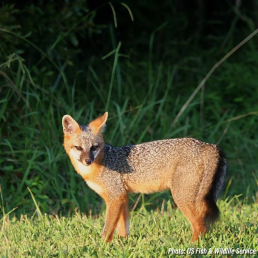Gray Fox Hunting and Trapping Season Closed Indefinitely
SHARE THIS POST
The hunting and trapping seasons for gray fox (Urocyon cinereoargenteus) in Illinois are closed effective immediately.
Surveys and preliminary results of current research indicate a substantial decline in gray fox distribution and abundance in the last ten years. Even though Illinois hunters and trappers harvest very few gray foxes, this closure will remove any additional pressure and additive mortality from harvest. The Illinois Department of Natural Resources (IDNR) will continue to conduct annual surveys and evaluate the gray fox population in Illinois.
On June 30, Gov. JB Pritzker signed into law Public Act 104-0019, which changed language in the Illinois Wildlife Code and allows IDNR to open or close the gray fox season by administrative rule. This bill was an IDNR initiative with broad support from diverse conservation groups including the Illinois Trappers Association and support from legislators across the state. On July 9, the department filed administrative rules indefinitely closing the hunting and trapping seasons for gray fox.
Research indicates the gray fox population is on the decline and the closure of the hunting and trapping seasons is a responsible change to protect the species and is supported by most hunters and trappers. Reasons for this decline are complex, but most research indicates that diseases such as canine distemper and competition from other canids, like coyotes, are the primary causes.
Are you enjoying this post?
You can be among the first to get the latest info on where to go, what to use and how to use it!
IDNR uses the best available science to guide the management of furbearers in Illinois. In the last 25 years, the department opened a trapping season for river otter and a hunting and trapping season for bobcat. The data from research and surveys indicate the populations can support a carefully managed otter and bobcat season and allow these species to thrive throughout the state. IDNR will continue to monitor the population and look for ways to reverse the decline.
You’ll find information on what’s happening in the Midwest with information from state DNRs and Forest Preserve Districts in every issue of MidWest Outdoors, available by subscribing on our website.
MWO
SHARE THIS POST
You may also like...
Nothing found.
Did you enjoy this post?
You can be among the first to get the latest info on where to go, what to use and how to use it!
MWO
We believe being outdoors is good. With more than 1,000 articles each year, MidWest Outdoors magazine is all about sharing outdoor experiences with you—where to go, what to use and how to use it… whether you’re close to home or on that trip of a lifetime.
